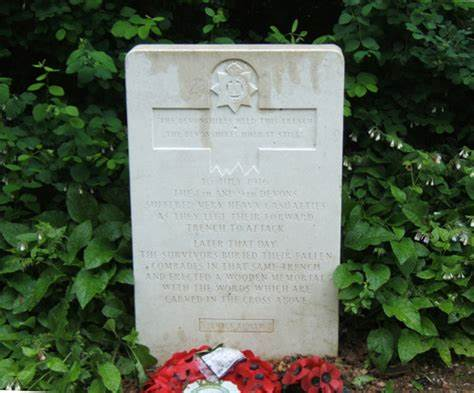William James Adams
 |
| William James Adams |
 |
| Lennox Martin |
Martin Middlebrook wrote in his book ‘The First Day of The
Somme’
“A few soldiers
were still able to come home on leave, among them a Capt. D.L. Martin, a
company commander in the 9th Devons. He took with him a large-scale map of the
area his company was to attack: some German trenches in front of Mametz.
While on leave, Capt. Martin, an artist, amused himself by making a plasticine
model of the battlefield. The longer he looked at the model, the stronger his
feeling grew that if and when his company advanced over a small rise by some
trees called Mansel Copse, they would come under fire from a German machine-gun
position built into the base of a wayside shrine in Mametz. On his return, he
showed the model to his brother officers and told them of his forecast”.
At 7.30 am, zero-hour, 1st of July 1916, Captain
Martin said to his men as the attack began, as realised that his prediction
would be fulfilled?
“Just outside
Mametz, the 9th Devons did not attack from their front-line trench which had
been badly damaged by shell fire, but from the support line. As Capt. Martin
led his company forward at zero hour, they were for some time sheltered by the
small hill at Mansel Copse but as the Devons topped the rise and moved
downhill, they were in full view of any enemy who might have survived the
bombardment.
A single machine
gun, built into the base of the crucifix on the edge of the village, exactly
where Capt. Martin forecast was only 400 yards away – easy range for a
competent machine-gunner. The crew had survived; the gun was not damaged and
when it opened fire, it caught the Devons on the exposed slope. Scores of men
went down, among them Capt. Martin, killed at the exact spot by Mansel Copse
that he had predicted from his model would be where his company would be
doomed”
Lieutenant William Noel Hodgson, the officer who was
responsible for the 9th Battalion, was kept supplied with grenades
and seemed to be aware of the fate of the Battalion. Days earlier, on the 29th of June,
under the pseudonym of Edward Melbourne wrote a poem called “Before Action”
By all the glories
of the day
And the cool evening’s benison
By that last sunset touch that lay
Upon the hills when day was done,
By beauty lavishly outpoured
And blessings carelessly received,
By all the days that I have lived
Make me a soldier, Lord.
By all of all
man’s hopes and fears
And all the wonders poets sing,
The laughter of unclouded years,
And every sad and lovely thing;
By the romantic ages stored
With high endeavour that was his,
By all his mad catastrophes
Make me a man, O Lord.
I, that on my
familiar hill
Saw with uncomprehending eyes
A hundred of thy sunsets spill
Their fresh and sanguine sacrifice,
Ere the sun swings his noonday sword
Must say good-bye to all of this; –
By all delights that I shall miss,
Help me to die, O Lord.
 |
| Devonshire Cemetery, Mametz |
The soldiers of the 9th Battalion were buried at the Devonshire Cemetery, Mametz. The memorial stone declares, “The Devonshires held this trench; the Devonshires hold it still.”
One of those soldiers who saw action on the First Day was
Lance Corporal William James Adams.
James was injured and brought back to the United Kingdom.
Born in 1899, he was the son of David George Adams and Mary
Ann Lane, who were married in December 1896 at St. James church.
At the time of the 1901 Census, the Adams family was
residing at 61 Penteguinea Road.
 |
| 1901 Census |
David was 31 years old and employed as a General
Labourer. Mary was 21 years old. Their only child at the time of the census
was William aged 2 years.
Also present at the property was David’s brother, Charles,
19, who was employed as a General Labourer.
Bordering at the address was 50-year-old John Thomas, who
was employed as an Engine Driver.
A decade later, at the time of the 1911 census, the Adams
family had moved to 61 Midland Terrace, St. Thomas.
 |
| 1911 Census |
David, 41, is now employed as a Dock Labourer. Mary Ann is 31 years old. Their young family include the children
William, 12; Evlyn, 10, who both attend school; Edwin, 8;
Grace, 5; and 2-year-old Elsie.
Also residing at the address was 22-year-old fisherman Giles
Taylor.
 |
| William James Adams Danygraig Cemetery credit - findagrave |
Following his death, William was buried at Danygraig Cemetery.


Comments
Post a Comment